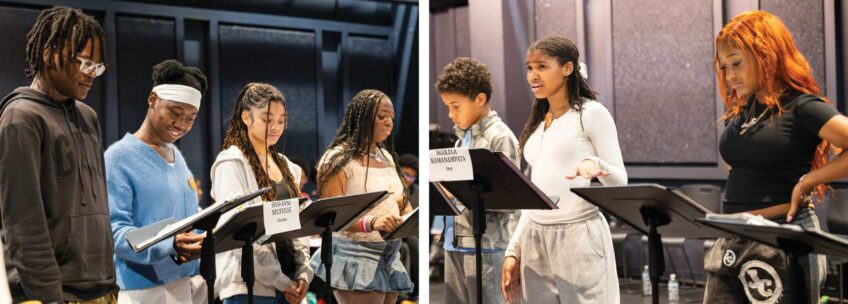

Author: artist and Galerie Lelong, New YorkVisitors are immersed in the sounds of the Iraq war in a simulated empty warehouse as part of “…OUT OF HERE: The Veterans Project” at the ICA.
Bringing a war that remains remote to many Americans closer to home is the multi-media installation by Krzysztof Wodiczko, “ … OUT OF HERE: The Veterans Project,” on view through March 28, 2010 at the Institute of Contemporary Art, Boston.
A terse, 10-minute narrative unfolds across three walls in a darkened gallery where viewers stand, sit and sprawl on a carpeted floor. Projections turn the gallery into the interior of an abandoned warehouse with a long, narrow band of murky windows.
Viewers are immersed in the sounds of an occupied Iraqi city — the imam’s chants from the loud speaker of mosque, the shouts of children at play. A soccer ball shoots by a window and the shadow of a helicopter looms against a wall.
Minutes later, the walls reverberate with an IED explosion, a woman’s voice rises in a wail, and American soldiers shout orders to the staccato ripples of sniper fire. Events outside the building progressively stain and shatter the windows and pierce the walls. Then the scars fade from view and the video begins again.
Unlike most of Wodiczko’s other installations, which present eyewitness testimonies, this installation is a work of fiction, but no less truthful, inspired by his interviews with medics, soldiers and refugees.
Wodiczko, 66, director of the MIT Center for Science, Art and Technology, has created more than 80 large-scale video and audio projections that give voice to those whose lives have been devastated by violence — and silence. Most are on landmark civic buildings and monuments, investing these public structures with new meanings and stories.
In a work commissioned by the ICA, “Bunker Hill Monument Projection” (1998), parents and friends of murder victims break their silence about gun violence in Charlestown, their faces and voices projected on the Bunker Hill Monument. In the shadow of this memorial to the American Revolution, Wodiczko wrote, “The battle continues for life, liberty and the pursuit of happiness.”
“A memorial should be a vehicle through which the past and future converge,” said Wodiczko, speaking of his installation “Hiroshima Project” (1999). A video shows only the hands of survivors as they describe their memories of the first atomic bomb attack. The images are layered over a view of the river that is now part of the Hiroshima Peace Memorial Park. “The river became a graveyard for both people and buildings in Hiroshima,” said Wodiczko, noting that the survivors have turned it into a scene “both of tragic witness and also of hope, because it’s moving and new water is coming.”
What Wodiczko’s installations have in common is their transformative power as art, not mere confessions. Asked how he engages people who have suffered traumatic experiences in publicly sharing their stories, Wodiczko said that he works to “create conditions for public testimony, in which the victims become artists themselves.”
The process of gaining participants’ trust can take many months, explained Wodiczko. After proposing a project, he said, “First, it is rejected. The project is destroyed. That’s very important. Then I show up again. I survive the destruction.”
In a small gallery leading into the ICA installation, video monitors with headphones show excerpts from other installations by Wodiczko that explore the toll of war in Iraq and Afghanistan on Coalition soldiers. The small-scale format barely hints at the impact of the original presentations, which were massive public spectacles.
Two videos show clips from “Veteran Vehicle Project” (2008), held in Denver during the Democratic National Convention, and “War Veteran Vehicle” (2009), staged in Liverpool, England.
In both projects, Wodiczko re-engineered the iconic military vehicle of each nation—America’s Hummer and Britain’s Land Rover—into another sort of mobile combat unit. Instead of carrying a missile launcher, the weapon platform became the mount for a video-and-audio projection unit. Soldiers and their loved ones used the equipment to record and broadcast their stories.
Driven by veterans, these roving units transmitted their testimonies onto the facades of major buildings and monuments. First came the story, such as a Liverpool wife telling of her husband’s struggle with battlefield trauma. As she spoke, her words were projected onto the bell tower of the Liverpool Metropolitan Cathedral. Then single words or potent phrases were repeated, each punctuated by a shot of gunfire. The installation turns words into weapons that pierce public distance and indifference.
The third video shows a scene from “Veterans’ Flame” (2009), which Wodiczko staged in the historic fort complex on Governors’ Island in New York City. A candle flickers as if in response to the voices of soldiers as they speak of fallen comrades in Afghanistan and Iraq.
Speaking on Veterans Day at the ICA, Wodiczko was joined by several people who had worked on the installation. Tala Khudairi, a native of Iraq, provided the voice of the wailing mother. Two participants were Iraq veterans: Michael Anthony, author of “Mass Casualties: A Young Medic’s True Story of Death, Deception, and Dishonor in Iraq”; and James O’Neill, an artist whose expressionistic monotypes are inspired by his experience in Iraq.
“Lots of people are not included in our Veteran’s Day who are proper veterans,” said Wodiczko, speaking of the families of soldiers and civilians. “We should include them.”
The recipient of the Hiroshima Art Prize (1999) for artistic works that contribute to world peace, Wodiczko told the audience, “Peace cannot be sustained by peaceful means.”
Recalling his youth in Poland, he said, “Peace was assured by gangsters very good about making everybody peaceful.”
Wodiczko’s installations disturb the peace, bearing witness to suffering and injustice.
“Breaking through the wall of silence is difficult,” Wodiczko said. “But it is imperative to try.”






